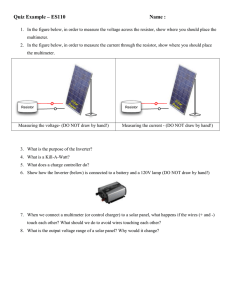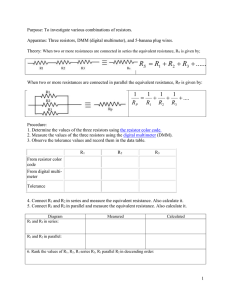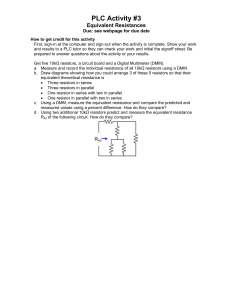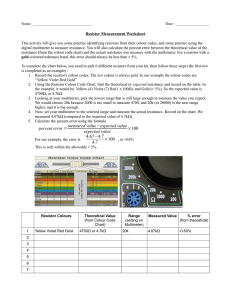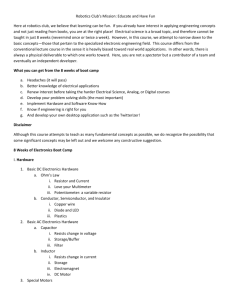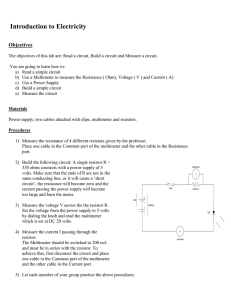Digital Multimeter (DMM) Calibration, DIY
advertisement
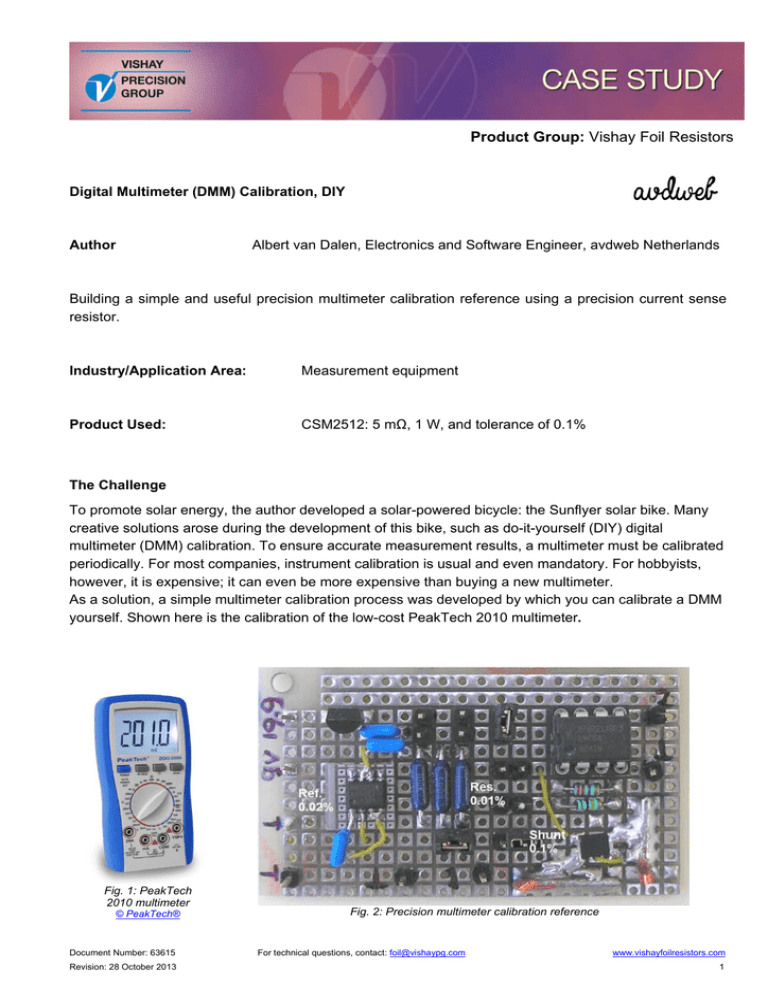
Product Group: Vishay Foil Resistors Digital Multimeter (DMM) Calibration, DIY Author Albert van Dalen, Electronics and Software Engineer, avdweb Netherlands Building a simple and useful precision multimeter calibration reference using a precision current sense resistor. Industry/Application Area: Measurement equipment Product Used: CSM2512: 5 mΩ, 1 W, and tolerance of 0.1% The Challenge To promote solar energy, the author developed a solar-powered bicycle: the Sunflyer solar bike. Many creative solutions arose during the development of this bike, such as do-it-yourself (DIY) digital multimeter (DMM) calibration. To ensure accurate measurement results, a multimeter must be calibrated periodically. For most companies, instrument calibration is usual and even mandatory. For hobbyists, however, it is expensive; it can even be more expensive than buying a new multimeter. As a solution, a simple multimeter calibration process was developed by which you can calibrate a DMM yourself. Shown here is the calibration of the low-cost PeakTech 2010 multimeter. Fig. 1: PeakTech 2010 multimeter © PeakTech® Document Number: 63615 Revision: 28 October 2013 Fig. 2: Precision multimeter calibration reference For technical questions, contact: foil@vishaypg.com www.vishayfoilresistors.com 1 Product Group: Vishay Foil Resistors Fig. 3: Diagram of precision multimeter calibration reference So what is a DMM? As analog circuits become more complex and require tighter tolerances, different parameters — such as current, voltage, and resistance — must be measured with a high degree of accuracy to validate the required specifications. A DMM is a measuring instrument that diagnoses circuit functions and parameters, and combines several measurement functions in one piece. Basic multimeter features would be the ability to measure current, voltage, resistance, frequency, period, capacitance, and temperature. There are two kind of multimeters: analog and digital. Analog devices use a microammeter whose pointer moves over a scale calibrated for all the different measurements that can be made. Digital multimeters display the measured value in numerals, and may also display a bar of a length proportional to the quantity being measured. The Solution Vishay Foil Resistor's 5 mΩ, 1 W CSM2512 precision current sensing resistor was utilized to develop the multimeter calibration reference. The device features a low thermal electromotive force (EMF) that is critical in many precision DC applications. The CSM2512’s all-welded construction is composed of a Bulk Metal® resistive element with welded copper terminations, plated for soldering. The terminations make true ohmic contact with the resistive layer along the entire side of the resistive element, thereby minimizing temperature variations. In addition, the resistor element is designed to uniformly dissipate power without creating hot spots, while the welded terminations' material is compatible with the element material. Document Number: 63615 Revision: 28 October 2013 For technical questions, contact: foil@vishaypg.com Fig. 4: CSM2512 Current Sensing Resistor www.vishayfoilresistors.com 2 Product Group: Vishay Foil Resistors The stability problems associated with analog circuits are very pervasive, but knowledgeable selection of a few high-quality resistors, networks, or trimming potentiometers in critical locations can greatly improve circuit performance, long-term application-related performance, as well as the designer’s peace of mind. Additionally, the overall system cost is often reduced when a knowledgeable designer concentrates costs in a few exceptionally stable components whose proven minimal-deviation load and environmental stability can often eliminate the necessity of additional compensating circuitry or temperature-controlling systems. The higher reliability and better overall system performances also produce excellent results in the field, enhancing market acceptance and product reputation. Designers often unnecessarily pay for tighter tolerances than required simply to accommodate the resistance stability shifts they know to be imminent in an application due to the large application-related changes in the components they selected. Selection of a high-stability component like the CSM2512 in these applications eliminates the need for shift allowance due to “planned instability” and allows the use of looser initial tolerances than would be necessary with current-sensing resistors based on other technologies. The User Explains With its four-terminal Kelvin design, VFR's CSM2512 precision current sense resistor made it possible to build a simple precision multimeter current calibration reference. It is not necessary to perform adjustments inside the multimeter, and often this is not possible. It is sufficient to correct the DMM reading with a correction factor obtained with the calibration. The AC measurement ranges are not Fig. 5: Four-terminal Kelvin design calibrated, which isn't a problem since in practice only DC voltages need to be measured accurately. The analog-to-digital converters, used in DMMs, are inherently linear. Due to dielectric absorption in the integrating capacitor and the slew rate of both the integrator and comparator, however, very small linearity errors can occur near zero and full scale. Therefore the ADC linearity has to be checked, especially at 10 % and 90 % of full scale. Note that the resistor network has to be turned over for the 90 % level test. Document Number: 63615 Revision: 28 October 2013 Fig. 6: DMM linearity test, DIY For technical questions, contact: foil@vishaypg.com www.vishayfoilresistors.com 3 Product Group: Vishay Foil Resistors “The use of the Bulk Metal® Foil Current Sense Resistor was the only way to build a current calibration. This precision resistor comes with a very high accuracy. No adjustment is needed.” Reference http://www.avdweb.nl/tech-tips/multimeter-calibration-diy.html Contact Information Albert van Dalen avdweb Maastricht, Netherlands Web site: www.avdweb.nl Vishay Precision Group, Inc. (VPG) Vishay Foil Resistors foil@vishaypg.com Click here for your regional VFR contact. Document Number: 63615 Revision: 28 October 2013 For technical questions, contact: foil@vishaypg.com www.vishayfoilresistors.com 4
